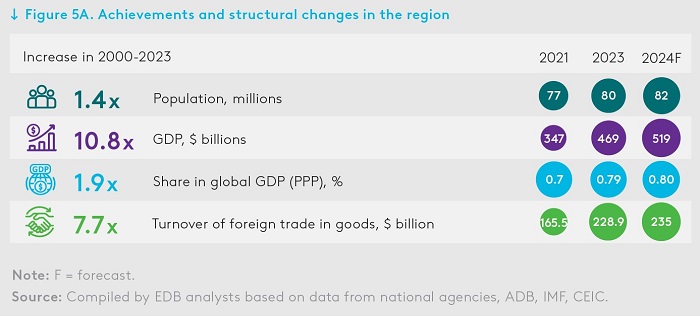The three largest economies — Kazakhstan, Uzbekistan and Turkmenistan — account for 95% of Central Asia’s total GDP and are net exporters of hydrocarbons, says Eurasian Development Bank (EDB) in the reports titled “Macroeconomic Forecasts 2025-2027”.
In 2024, Central Asia’s nominal GDP could exceed $500bn. According to our estimates, it will increase by more than 10% and reach $519bn.
Kyrgyzstan’s and Tajikistan’s exports are chiefly metals and metal ores. All countries in the region have open economies, with the Kyrgyz Republic being the leader in terms of involvement in foreign trade.
 The report emphasizes that Central Asian economies have been growing strongly over the past two years despite external challenges. GDP growth averaged 4.8% YoY in 2022–2023, while emerging markets grew by 4.2% YoY and the global economy by 3.4% YoY. Over the past 24 years, the region’s total GDP has increased 10.8 times and its share of world GDP based on PPP terms has increased 1.9 times.
The report emphasizes that Central Asian economies have been growing strongly over the past two years despite external challenges. GDP growth averaged 4.8% YoY in 2022–2023, while emerging markets grew by 4.2% YoY and the global economy by 3.4% YoY. Over the past 24 years, the region’s total GDP has increased 10.8 times and its share of world GDP based on PPP terms has increased 1.9 times.
Demographic trends are fueling the growth of the economies of the Central Asian states. The population of Central Asia has reached 80 million, growing by 3.7% since 2021 and 1.4 times in the last 24 years. The age distribution of the population suggests that the labour force will grow in the future. Uzbekistan is the most populous country in the region, with 45 % of Central Asia’s population.
The volume of accumulated foreign investments from third countries has increased by 4.2% over the last two years and is estimated at $223 billion at the end of 2023. A strong performance was also noted in foreign trade turnover, which has increased by 34.6% since 2021.
The Bank predicts a growing strategic role for Central Asia in the vast Eurasian space.
“The transit position of the region’s countries and their integration into emerging international transport corridors is an opportunity to access external markets and increase the potential of economies”, the report says.
Coordinated development of the water and energy sector, including green energy, offers significant opportunities. In order to unlock the region’s potential, it is important for countries to overcome other challenges, such as landlockedness, resource dependence, a low level of financial development, and the impact of climate change.
The report “Macroeconomic forecasts 2025-2027” is available here: https://eabr.org/upload/iblock/511/EDB_Macroreview_2025_2027_Summary_EN.pdf ///nCa, 15 January 2025